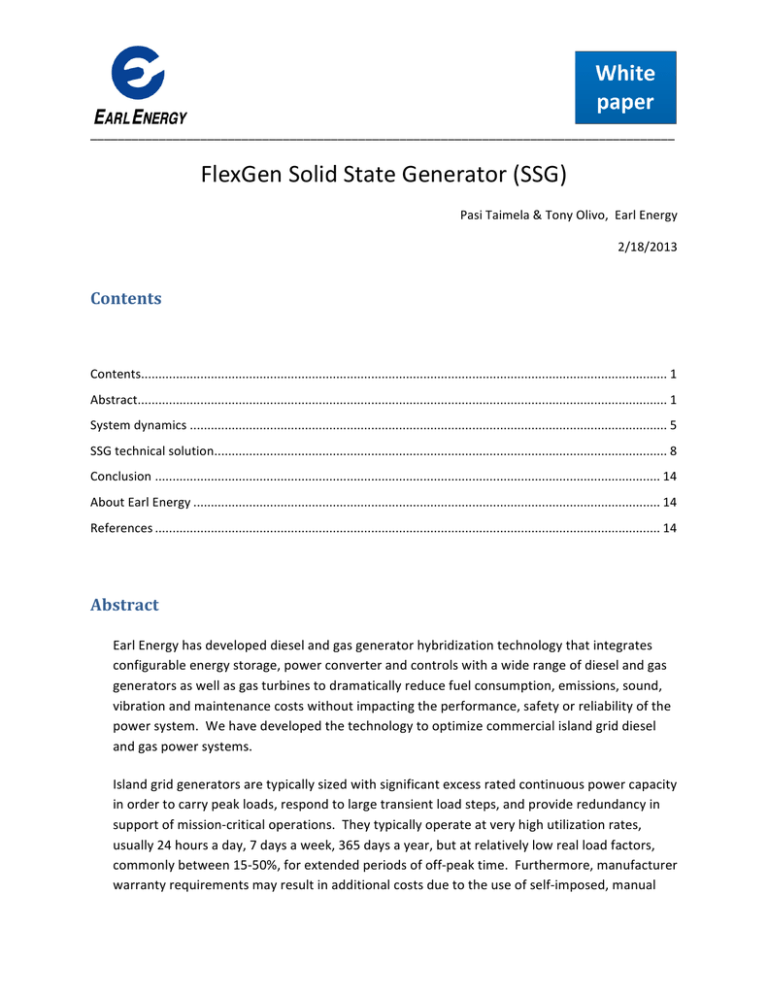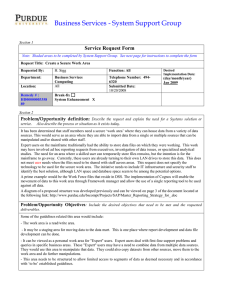FlexGen Solid State Generator (SSG)
advertisement

_____________________________________________________________________________________ FlexGen Solid State Generator (SSG) Pasi Taimela & Tony Olivo, Earl Energy 2/18/2013 Contents Contents ....................................................................................................................................................... 1 Abstract ........................................................................................................................................................ 1 System dynamics ......................................................................................................................................... 5 SSG technical solution .................................................................................................................................. 8 Conclusion ................................................................................................................................................. 14 About Earl Energy ...................................................................................................................................... 14 References ................................................................................................................................................. 14 Abstract Earl Energy has developed diesel and gas generator hybridization technology that integrates configurable energy storage, power converter and controls with a wide range of diesel and gas generators as well as gas turbines to dramatically reduce fuel consumption, emissions, sound, vibration and maintenance costs without impacting the performance, safety or reliability of the power system. We have developed the technology to optimize commercial island grid diesel and gas power systems. Island grid generators are typically sized with significant excess rated continuous power capacity in order to carry peak loads, respond to large transient load steps, and provide redundancy in support of mission-­‐critical operations. They typically operate at very high utilization rates, usually 24 hours a day, 7 days a week, 365 days a year, but at relatively low real load factors, commonly between 15-­‐50%, for extended periods of off-­‐peak time. Furthermore, manufacturer warranty requirements may result in additional costs due to the use of self-­‐imposed, manual _____________________________________________________________________________________ load banks. This operating profile results in lower fuel efficiency, excessive wear and tear on generators, and notable increases in Particulate Matter (“PM”) and Hydrocarbon (“HC”) emissions due to the incomplete combustion of diesel or natural gas fuel. Earl Energy’s solid state generator eliminates this systematic inefficiency by hybridizing the generator. In this white paper, the solid state generator concept (SSG) is introduced. A typical diesel generator with a 100kW – 1MW power range is capable of meeting a 5% frequency regulation while a maximum load of 50% is applied in one step. Figure 1 shows the response to a 100% load step being applied to a diesel generator. Figure 1, Diesel generator step response The typical target for frequency accuracy for marine, industrial and residential loads is 5% or (+-­‐2.5Hz). The generator used in the above example cannot meet this specification with a 100% load step. Natural gas is becoming a more desirable fuel for power generation than diesel, because of lower fuel cost and improved emissions. The drawback with natural gas engines are reduced step response capability and poor control performance with light loads. The table below presents a snapshot of a CAT G3500C series natural gas engine’s step response performance. _____________________________________________________________________________________ If the load requires a 5% frequency regulation, the above engine is capable of accepting only a 10% load change vs. a diesel engine which would accept a 50% load change. There are countless different load profiles which different island grid generators may support. Figure 2shows a repetitive load profile that may be seen in an industrial, marine or oil & gas site. Figure 2, Example load profile of repetitive industrial load, y-­‐axis (load in [kW]), x-­‐axis (time in minutes), red is kW, Blue is kVA _____________________________________________________________________________________ In order to apply systematic analysis for a generic load profile, Earl Energy has developed an analysis method that applies the following metrics to a generic load profile: Metric 1 2 3 4 5 6 7 8 9 Description Average power Base load Peak load Number of transient peaks Rise time in 25, 50, 75 and 100% of peak Fall time in 25, 50, 75 and 100% of peak Duration of peaks Load bank usage kWh Multi generator run time Unit of measures [kW] [kW] [kW] [count] [kW/s] [kW/s] [s] [kWh] [s] Based on the above metrics and customer specific cost of fuel information, it is possible to select the optimal size SSG storage and power converter model for each customer application. In order to determine the full cost of ownership in an island grid generator installation and operation, the following costs will be accounted for: • • • • • • • • • • • • • • Initial cost of engine(s) Initial cost of alternator(s) Cost of power system materials, breakers, wiring, fusing, transformers Load bank capital cost Initial installation cost Fuel cost to support end customer load Fuel cost to support load bank (if applicable) Fuel cost of running second redundant generator (if applicable) Maintenance cost of second redundant generator Cost of generator inefficiency (non-­‐optimal operating point) Generator maintenance cost, oil, filters, routine maintenance Periodic generator top end and major overhauls HVAC cost to condition engine room (if applicable) Excess capital and maintenance cost of equipment engineered to operate under large frequency deviations: motors, variable frequency drives, pumps, etc. _____________________________________________________________________________________ Once an industrial island grid power system is designed, special attention should then be paid to back-­‐ feed power considerations. If the load profile has a regenerative / back-­‐feed power requirement, an active motor break or passive load bank is required. An island grid generator would not be capable of sinking significant amounts of energy. In the case of reverse power, the generator would go over speed, trip off due to over frequency or possibly suffer damage to the alternator or engine. In order to properly design the power system, load banks are commonly used. Drawbacks of using the load bank are excessive fuel consumption and in some cases increased heat. Load banks are also used for pre-­‐loading the generator, so that in the initial load step, it would meet the desired transient frequency requirement. If a passive load bank is used for creating this base load, it also creates an unnecessary operational cost burden. In order to minimize these unwanted load bank energy charges, the SSG system can be used. The SSG system not only addresses the transient response issues but also functions as an electronic load bank as an added benefit. System dynamics In order to fully understand the physics behind the limited step response capability of diesel and natural gas engines, it is useful to look into a formula that represents mechanical and electrical energy parameters in a dynamical system model. 1 E = 2 Iw 2 T = TM - P L = Ia w , where E = kinetic energy stored in the rotor I = rotational inertia (related to the mass of the rotor) ω = angular velocity T = total rotor torque PL = electrical load TM = engine torque, controlled by injection rate and engine governor lag α = rotational acceleration _____________________________________________________________________________________ Typical natural gas engines use a single manifold fuel feed, which limits how fast a pressurized fuel mixture of oxygen and natural gas can be increased in a combustion chamber. This lag will restrict how fast the mechanical torque can be increased. As can be seen from the above formula, if there is a constant power demand from the load, given the limited mechanical torque change, the speed of the engine will change as a function of kinetic mass. There is a direct relationship between axle speed and output to critical customer load bus frequency. If a customer has certain frequency regulation requirements, the above dynamical dependency will limit the maximum single load step that a natural gas engine can support. Historically system engineers have addressed the frequency step response issue by oversizing generators, or utilizing additional mechanical mass, like flywheels, to mitigate the issue through mechanical means. Other mechanical engineering solutions to transient problems include dual fuel and dual-­‐concentric needle design. All these improve the situation but do not solve the fundamental issue of insufficient power during transients. If these alternative mechanical engineering based solutions are used, there still remains the challenge of natural gas engines that require load bank usage. Modern high efficiency power conversion and high efficiency storage chemistries enable system designs that add electrical energy storage, which overcomes the limitations of mechanical energy storage. Due to recent advances in technology, the SSG electrochemical storage can be sized in a cost efficient manner while at the same time using a smaller footprint. SSG enables natural gas engines step response to meet and exceed the diesel engines step response performance. The best time to consider SSG is during the initial system design of new construction. When properly considered, the benefits of the SSG system include: reducing the generator size, matching the average load, removal of load banks, increased fuel efficiency, and lower emissions. In the below picture, the basic operation principle of SSG is presented. _____________________________________________________________________________________ 600 500 400 300 200 Load 100 Generator 0 -­‐100 1 3 5 7 9 11 13 15 17 19 21 23 25 27 29 31 SSG -­‐200 -­‐300 -­‐400 Figure 3, Basic SSG Operation Traditionally generator controllers are programmed to implement frequency droop to enable paralleling and improve the frequency response. In the case of a resistive or passive load, this droop method may be useful in addressing the frequency regulation problem. However, now most industrial processes are using active Variable Frequency Drives (VFD) which demands constant power. In the case of a constant power load, voltage drop due to the frequency droop causes harm, exceeding current ratings of devices, and prematurely tripping circuit breakers. When using SSG as part of a system, the active VFD loads are fully served from SSG without any adverse effect to generator. SSG will provide transient magnetizing current as well as energy storage, allowing an engine to operate within its dynamic response capability limits and optimal operation point at all times. This also results in improved fuel efficiency and reduced emissions. _____________________________________________________________________________________ SSG technical solution SSG technical solution consists of an energy storage unit, power converter and control unit as shown in the below picture. Controller ECU M G Genset Control Board Storage DC/DC DC/AC SSG R Customer Load Figure 4, SSG system solution _____________________________________________________________________________________ In Figure 5, the SSG system behavior is illustrated during a 100kW to 1MW (90%) load step. Below, the storage element charge level is illustrated on the left side of the figure. The blue arrow illustrates the SSG active power flow. After this sequence, the storage will be charged back to its desired average charge level (not shown in this chart). Figure 5, SSG charge level and power flow during load step _____________________________________________________________________________________ In Figure 6, the SSG behavior is demonstrated during load removal in the case of non-­‐regenerative braking. Figure 6, SSG charge level and power flow during load removal In order to best optimize the SSG storage element, a proper storage chemistry and size has to be considered. Due to significant investments from governments and large corporations, there are several commercially available high-­‐efficiency storage chemistries available, such as different variants of Li-­‐Ion, NiZn, ultra-­‐capacitors, and hybrid ultra-­‐capacitor solutions. _____________________________________________________________________________________ The table below shows several different storage chemistry solutions where volumetric size is compared as a function of run time in minutes. 14.00 Li-­‐Ion -­‐ Phosphate 12.00 Li-­‐Ion -­‐ Manganese oxide 10.00 Li-­‐Ion -­‐ Metal oxide 8.00 Li-­‐Ion -­‐ Titanete oxide 6.00 Ultra capacitor 4.00 Nickel Zinc 2.00 Nickel Zinc, Q4/2013 0.00 0 1 2 3 4 5 6 Figure 7, Volumetric size of storage [Number of IT racks], as function of discharge time [minutes] The chart shows that in order to maintain a reasonable volumetric size of an ultra-­‐capacitor solution, runtime is limited to under 2 minutes. In order to better visualize the differences between the other chemistries, the same information is plotted without ultra-­‐capacitors. _____________________________________________________________________________________ 6.00 Li-­‐Ion -­‐ Phosphate 5.00 Li-­‐Ion -­‐ Manganese oxide 4.00 Li-­‐Ion -­‐ Metal oxide 3.00 Li-­‐Ion -­‐ Titanete oxide 2.00 Nickel Zinc 1.00 Nickel Zinc, Q4/2013 0.00 0 10 20 30 40 50 Figure 8, Volumetric size of storage [Number of IT racks], as function of discharge time [minutes] The cyclic load profiles found in industrial and O&G customer cases may require as high as 100,000 cycles in a 3 – 5 year storage life. A 5 year life is considered a desired minimal customer requirement for fielded life expectancy. Based on the above chart, the ideal storage chemistry for short duration transient response electrochemical storage would be a NiZn or Li-­‐Ion titanate oxide (“LTO”). However, before the final selection of storage chemistry, the cycle life capability of each chemistry must be considered. LTO cycle life can be as high as 6,000-­‐9,000 full depth of discharge cycles as specified from vendors. When very light depth of discharge usage occurs as part of SSG, the Li-­‐Ion battery may meet the 100,000 cycle requirement. Depending on a specific customer’s load profile, LTO may be a suitable option for storage selection – given that environmental and cost requirements meet customer needs. NiZn has a very limited cycle life. It is not suitable for high cycle life application – even though it is the most energy dense storage chemistry available. A typical ultra-­‐capacitor cycle life is 1,000,000 cycles. The life of an ultra-­‐capacitor is mostly a function of float voltage and temperature. In the SSG application, the float voltage is kept low, in order to have storage available for regenerative braking. That enables a full potential life cycle of storage without any oversizing. _____________________________________________________________________________________ The technical challenge of utilizing ultra-­‐capacitors is a wider voltage swing compared to other storage chemistries. Earl Energy is addressing the proper power conversion selection by utilizing rugged, high overload capable, water cooled drives. Power converters are selected to use a topology that enables maximum extraction of energy in all operating conditions from ultra-­‐capacitors. Business Development In order for the SSG product’s value to be made clear to the customer, the cost metrics identified in the abstract of this white paper must be addressed. Earl Energy has developed an algorithm for automatically reading customer profiles, and identifying major features, as shown in Figure 9. This allows for the quantification of customer costs, such as: • • • • Average utilization of asset generation capability Excessive load bank usage Time spent slowly ramping up load levels for transient response Extra generator operation for transient response or peak handling capability Metrics on these and other costs allow an SSG system to be optimized for a customer’s application without requiring direct communication with other devices in the site installation, and producing a maximum return on investment for the customer. Figure 9, Machine simplification of customer profiles _____________________________________________________________________________________ Conclusion As presented in the above description, Earl Energy has developed a unique product (SSG), which achieves significant cost savings through a technical solution for power generation challenges. The main benefits of the SSG system are: • • • • • • • • • Savings in initial engine cost Reduced size requirement of alternator Reduced cost of power system materials, breakers, wiring, fusing, transformers Removal of load banks Reduced installation cost Reduced ongoing fuel expense Removed redundant generator Generator maintenance cost, oil, filters, routine maintenance Reduced number of generator overhaul About Earl Energy Earl Energy, LLC is a veteran owned business headquartered in Virginia Beach, VA with a research, development and engineering facility in Durham, NC. Earl Energy’s develops intelligent energy management solutions for the entire power generation spectrum, from 3kW to 4MW systems. Specifically, Earl Energy designs and builds energy management products, under the brand name FlexGen™, that integrate high-­‐performance energy storage and power conversion to hybridize diesel and gas generators as well as gas turbines. These hybrid systems minimize fuel consumption, maintenance, and emissions. References [1.] G3500C I.M. Transient Performance.docx




